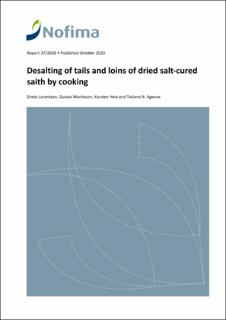| dc.contributor.author | Lorentzen, Grete Elisabeth | |
| dc.contributor.author | Martinsen, Gustav | |
| dc.contributor.author | Heia, Karsten | |
| dc.contributor.author | Ageeva, Tatiana Nikolaevna | |
| dc.date.accessioned | 2020-12-01T14:08:06Z | |
| dc.date.available | 2020-12-01T14:08:06Z | |
| dc.date.created | 2020-11-20T11:58:07Z | |
| dc.date.issued | 2020 | |
| dc.identifier.isbn | 978-82-8296-654-2 | |
| dc.identifier.uri | https://hdl.handle.net/11250/2711250 | |
| dc.description.abstract | Before preparation of a meal from the dried salt-cured fish, reducing the salt content by soaking the fish into water is commonly applied. In Jamaica and in the Dominican Republic, however, the salt content is reduced by cooking before further preparation and consumption. Despite long traditions for such a pre-treatment, descriptions on how cooking influences the salt content has to our knowledge, not been published. Thus, the aim of this work was to obtain knowledge on issues influencing the salt content in pieces of dried salt-cured saith when applying cooking as a method of desalting. Loins and tails of dried salt-cured saith were either rinsed in two minutes or rehydrated in cold water for two hours before cooking. After reaching 100 °C of the cooking water, the water was drained away, i.e., the cooking time was 0 min. In this experiment, the salt content in the tails were lower compared to the loins after each cooking session. Furthermore, the effect of rehydration in 2 hours was more distinct for the loins than for the tails, i.e., a lower salt content was obtained in loins being rehydrated for 2 hours than for those being rinsed for 2 min. The effect of prolonging the cooking time from 0 to 2 and 3 minutes was also studied. Pieces of tails were rinsed in 2 min prior to cooking. When compared to a cooking time of 0 min, the rate of salt loss did not increase with a cooking time of 2 or 3 min. Irrespective of tails or loins or pre-treatment before cooking, the final salt content of 5 to 6% was obtained. It is emphasized that smaller pieces or a rehydration in water over night would most probably result in a lower salt content of the cooked fish. | |
| dc.description.abstract | Det er undersøkt hvordan saltinnholdet i klippfisk av sei reduseres ved koking. Tradisjonell metode er å redusere saltinnholdet i klippfisk ved utvanning, mens i Jamaica og i den Dominikanske Republikk kokes saltet ut i stedet. Spord og loins stykker av klippfisk sei ble kokt i vann, og i forkant ble fisken enten skylt i vann i 2 minutter, eller lagt i vann i 2 timer. Koketider på 0, 2, og 3 minutter ble testet ut, og det ble tatt ut prøver for salt og vann analyse etter hver koking. I forsøk med en koketid på 0 minutter, var saltinnholdet i spord stykkene lavere sammenlignet med loins stykkene. Forbehandlingen, 2 minutter eller 2 timer utvanning, hadde størst betydning for loins, dvs 2 timer utvanning før koking, resulterte i det laveset saltinnholdet. Koketider på 2 og 3 minutter resultert ikke i et lavere saltinnhold i spord stykkene som ble testet ut. Uavhengig av om det var spord eller loins stykker, eller forbehandling før koking, var saltinnholdet i fra 5 til 6%. Det antas at dersom bitene hadde vært mindre, eller om bitene hadde vært vannet ut over natt før koking, hadde saltinnholdet vært lavere. | |
| dc.language.iso | eng | |
| dc.publisher | Nofima AS | |
| dc.relation.ispartof | Nofima rapportserie | |
| dc.relation.ispartofseries | Nofima rapportserie | |
| dc.relation.uri | https://nofimaas.sharepoint.com/:b:/s/public/EY9LcG6B6hVIkUMjVnZjQqUB1JXtSrZZKEStPYmk6SxC-Q?e=iabEyC | |
| dc.title | Desalting of tails and loins of dried salt-cured saith by cooking | |
| dc.title.alternative | Saltreduksjon i spord og loins stykker av klippfisk sei ved koking | |
| dc.type | Research report | |
| dc.description.version | publishedVersion | |
| dc.source.pagenumber | 18 | |
| dc.source.issue | 37/2020 | |
| dc.identifier.cristin | 1850355 | |
| dc.relation.project | Nofima AS: 13100 | |
| cristin.ispublished | true | |
| cristin.fulltext | original | |
